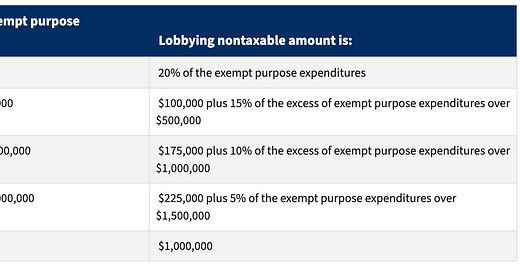Nonprofits: How to make your voice heard
Hello everyone,
I plan on going back to biweekly soon, but I wanted to talk a little about something I get asked about a lot from nonprofit organizations all the time: Can nonprofits do advcocacy? The answer is yes, but… There is a lot you can do and there is a lot that you cannot do. Considering the current political environment, not just against LGBTQIA+ rights but also against other communities such as immigrant communities.
While I will be talking about the specifics here, I do want to recommend this youtube video, which I often show to students about advocacy and lobbying. 501(c)(3)s and 501(c)(4)s have different rules around lobbying, as shown in this chart by AFJ. Below we will be looking at what 501(c)(3)s in the US can and cannot do. It is not extensive, but it does provide a conversation.
Nonprofit Lobbying:
501(h) election: To start, every nonprofit should fill out the 501(h) election. This changes advocacy from a vague thing to clear guidelines on how much money can be spent by nonprofit organizations on lobbying. You can find the paperwork here. It is easy to fill out and will take all the guess work out of lobbying. Foundations and houses of worship cannot do a 501(h) election.
So how much money can be spent?: Below is how much can be spent if one has a 501(h) election. If you do not have a 501(h) election, it is quite unclear.
What is lobbying?: According to the IRS, “Direct lobbying refers to attempts to influence a legislative body through communication with a member or employee of a legislative body, or with a government official who participates in formulating legislation. Grass roots lobbying refers to attempts to influence legislation by attempting to affect the opinion of the public with respect to the legislation and encouraging the audience to take action with respect to the legislation. In either case, the communications must refer to and reflect a view on the legislation.” Importantly, a nonprofit cannot endorse a candidate, but they can speak out about legislation or specific issues.
What is advocacy?: Advocacy includes:
Grassroots organizing
Public Education
Position Papers
Participating in Coalitions
Litigation and Boycotts
Electioneering: Nonprofits cannot engage in electioneering. According to Boardsource “Electioneering includes written or oral endorsement of a candidate, rating candidates, forming a Political Action Committee (PAC), coordinating educational or lobbying activities with a campaign, or contributing or soliciting funds for campaigns or candidates.”
Voter education: Nonprofits can do nonpartisan voter education. Nonprofits can (from a national level, though state-by-state laws may differ):
Register voters directly
Assist in voter registration
Educate voters about upcoming elections, candidates, and ballot measures
Engage directly with candidates
Host educational candidate events
Take positions on ballot measures
The IRS has more information on nonpartisan voter education here. Importantly, nonprofits CAN take a stand on public policy issues as long as you speak for or against a candidate for public office. A candidate CAN speak at an event as long as they speak in a non-candidate capacity. You CAN criticize actions of elected officials but you need to be very careful that it does not come off as electioneering. If you want to speak out about an elected official, AJC has a good guide here on what you can and cannot (or should not) do. Even if it is legally allowed, you want to make sure you are not being perceived as being partisan.
This is a quick guide to lobbying and advocacy that a nonprofit can do and cannot do. If you have further questions, I am happy to answer them.



